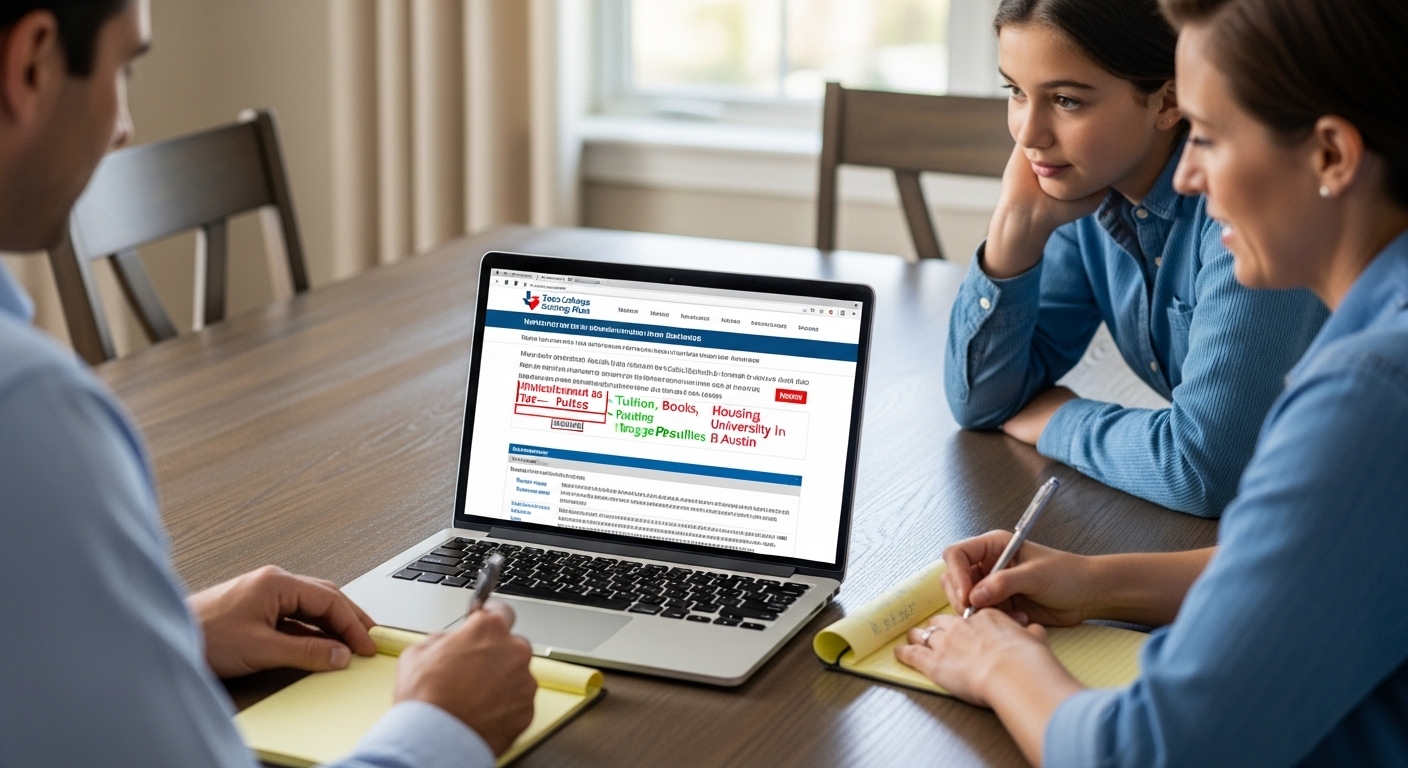College isn’t cheap in Texas, and every dollar counts when you’re juggling payroll, marketing, and family budgets. A 529 plan is a tax-advantaged account for education costs.
Knowing 529 plan texas withdrawal rules helps you keep tax savings intact and avoid penalties.
Here’s the short version. You can pull money tax-free when the withdrawal matches qualified education expenses paid in the same calendar year.
Miss the timing or spend on non-qualified costs, and the earnings portion may face taxes plus a 10 percent penalty.
Qualified expenses usually include tuition, fees, books, and housing, with K–12 tuition allowed up to $10,000 per year per child in 2025.
Some K–12 uses expanded in 2025, which adds flexibility for families and busy owners who need options.
There’s also added relief if college isn’t the path, since some plans allow future rollovers to a Roth IRA under certain conditions.
Picture this. The Garcias in Austin run a small landscaping business and save $300 a month for their daughter’s college.
They pay spring tuition in 2025, then withdraw the same amount from their 529 that year, keep receipts, and avoid taxes.
That same family sets aside part of the 529 for their son’s private high school tuition. They keep K–12 withdrawals under the $10,000 2025 cap, so their tax break stays intact.
Simple records, smart timing, fewer surprises. Upgrade your knowledge about the 529 plan via Max Contribution to 529 Plan (2025): Limits and Strategies.
If you’re a founder or marketer, cash flow timing matters. Treat 529 withdrawals like any other expense plan, match them to bills, and track everything. A little discipline protects returns you worked hard to build.
In this post, you’ll learn what counts as a qualified expense, how timing works, K–12 limits for 2025, tax pitfalls to avoid, and planning moves for families and small business owners.
By the end, you’ll know exactly how to apply 529 plan texas withdrawal rules to your situation and keep more of your money.
What Counts as a Qualified Withdrawal from Your Texas 529 Plan?

Smart use of your 529 affects taxes and cash flow. Here is how the 529 plan texas withdrawal rules define what you can pay for in 2025, so you keep every tax break you earned.
Key Education Expenses You Can Cover Tax-Free
You can withdraw tax-free when the cost is a qualified education expense and it is paid in the same calendar year as the distribution. College-level rules are broad, but timing still matters.
-
Tuition and mandatory fees: Covered at any eligible college, university, or trade school. This includes in-state, out-of-state, and many international schools on the federal list.
-
Required books and supplies: Textbooks, lab gear, studio materials, calculators, and course-required software.
-
Computer and tech: A laptop, printer, and internet service qualify if the student uses them for school. Example: buying a new laptop for online classes in August 2025 is qualified when the student needs it for coursework.
-
Room and board: Qualified if the student is enrolled at least half-time. On-campus housing is covered. Off-campus rent and meals are allowed up to the school’s published cost of attendance for room and board. Keep the housing allowance from the school’s website as your guardrail.
-
Special needs services: Equipment and services required for enrollment or attendance are qualified.
K–12 rules are tighter. For 2025, up to $10,000 per year, per child can be used for K–12 tuition at public, private, or religious schools.
Starting mid-2025, federal changes expand K–12 uses beyond tuition in many cases, such as curriculum for homeschool, tutoring, standardized test fees, and certain learning therapies for students with special needs.
-
Example: Paying a $6,000 private school tuition bill from the 529 in September, then $3,000 for approved tutoring later that year, stays under the $10,000 annual cap.
-
Apprenticeships: Registered apprenticeship programs qualify for required fees, books, supplies, and equipment.
Two quick checks that prevent headaches:
-
Match withdrawal dates to the year you paid the bill.
-
Save every receipt, invoice, and course list.
Texas-Specific Rules for K-12 and Apprenticeships
Texas follows federal definitions for qualified withdrawals, with clear guardrails for families. For K–12 in 2025, the $10,000 annual limit per beneficiary applies to tuition.
With the 2025 updates, qualified K–12 categories may include more than tuition, but the federal cap still controls the total per child for the year.
Good documentation keeps you audit-proof:
-
Tuition statements, invoices, and canceled checks
-
Itemized receipts for books, supplies, and laptops
-
For housing, keep the school’s cost-of-attendance room and board figure
-
For therapies, save provider credentials and notes tying services to learning needs
Apprenticeships are qualified when they are registered with the U.S. Department of Labor. You can use funds for required equipment, tools, books, and program fees.
Always confirm the program’s registration number and keep proof with your records.
Looking ahead, the K–12 annual cap increases to $20,000 starting in 2026. That gives Texas families more room to fund tuition and other qualified K–12 costs.
Small business tip: If you reimburse an employee’s education, separate that from your family’s 529 strategy. A 529 is best for a beneficiary you name, while employer education assistance has its own tax rules.
For owners hiring their teens, wages can help them qualify for a Roth IRA, while your 529 can still cover their school costs without mixing benefits.
Bottom line, stick to the 529 plan texas withdrawal rules, document everything, and align withdrawals with expenses in the same year. This keeps earnings tax-free and your planning clean.
How to Make Withdrawals Without Penalties or Extra Taxes

Using the 529 plan texas withdrawal rules the right way keeps every dollar working for you. The playbook is simple.
Match withdrawals to qualified expenses in the same calendar year, document everything, and avoid non-education spending.
Timing and Matching Your Withdrawals Correctly
Withdraw only what you actually spent on qualified costs in 2025. That is the core rule that keeps earnings tax-free at the federal level, and Texas has no state income tax to worry about.
-
Example: You pay $5,000 in spring tuition on March 15, 2025, then withdraw $5,000 from the 529 on April 1, 2025. Same year, same purpose, clean match.
-
If you withdraw more than you spent, the excess is non-qualified. The earnings portion of that extra amount becomes taxable and may face a 10% penalty.
Make matching easy with simple tools:
-
Use a dedicated 529 tracking sheet with columns for date, payee, category, amount, and withdrawal date.
-
Store PDFs in a cloud folder labeled by year and beneficiary. Include invoices, receipts, 1098‑T, housing cost‑of‑attendance caps, and bank proofs.
-
Reconcile quarterly. Compare your 2025 paid expenses with 2025 distributions, then fix any gaps before year‑end.
Keep records the IRS would expect:
-
Tuition statements, bursar bills, and cancelled checks or card statements
-
Itemized receipts for books, supplies, laptop, and internet used for school
-
For housing, keep the school’s room and board allowance if living off campus
Common Mistakes and How to Avoid Penalty Hits
Avoid these frequent pitfalls that break 529 plan texas withdrawal rules. Each one is fixable if you plan ahead.
-
Using funds for non-education purchases: Vacations, car payments, or general living costs do not qualify. Keep all 529 spending tied to eligible tuition, fees, books, tech, room and board, or approved K–12 categories.
-
Forgetting the same-year match: Paying a bill in December 2025 but withdrawing in January 2026 creates a mismatch. Always distribute in the same calendar year as the expense.
-
Exceeding K–12 limits: For 2025, the cap is $10,000 per year per child. Anything over that limit is treated as non-qualified for K–12.
-
Double-dipping with scholarships: If a scholarship covers tuition, make sure your 529 withdrawal is for other qualified costs, or use the scholarship exception properly.
Penalty math made simple:
-
Only the earnings portion of a non-qualified distribution is taxable and subject to a 10% penalty.
-
Example: You accidentally withdraw $2,000 for a non-qualified cost. If your 529 is 40% earnings, then $800 is taxable to the recipient and faces an $80 penalty.
Smart fixes if plans change:
-
Change the beneficiary to another family member who has qualified expenses.
-
Use the scholarship exception when the student gets a scholarship. You can withdraw up to the scholarship amount without the 10% penalty, though the earnings portion is still taxable.
-
Hold funds for a later term, an eligible trade program, or registered apprenticeship expenses.
When in doubt, slow down, confirm the category, and document. A one-minute review before you click withdraw can save you from taxes and penalties later.
Manage a 529 plan better by exploring our guide on How Do I Set Up a 529 Plan in 2025? Step-by-Step?
Exciting 2025 Updates and Long-Term Options for Texas 529 Plans

The 529 plan texas withdrawal rules just got more flexible, and the timing is perfect for busy Texas families. July 2025 expands what counts for K-12, and you get a powerful long-term backup with future Roth IRA rollovers.
Here is what changed, what is coming next, and how to use it.
A Texas family plans 2025 education expenses with 529 updates visible on a laptop and documents. Image created with AI.
New Expansions for K-12 and Beyond Starting This Year
Starting July 2025, federal updates broaden K-12 qualified expenses in many cases. You still must follow the 529 plan texas withdrawal rules and the annual K-12 cap for 2025, but you now have more approved categories to work with.
-
Tutoring and academic support tied to the student’s curriculum
-
Standardized test fees and prep materials
-
Curriculum and learning materials for homeschooling in eligible cases
-
Specialized therapies or services for students with documented learning needs
Use this simple table as a planning guide. Always retain invoices and provider details.
| K-12 Item | Qualified in 2025 (post-July) | Key Record to Keep |
|---|---|---|
| Tutoring | Yes, if tied to curriculum | Itemized invoice, curriculum link |
| Standardized tests | Yes | Test registration and payment |
| Curriculum/materials | Often, when core to instruction | Receipts and course outline |
| Learning therapies | Yes, when educational need exists | Provider credentials and notes |
Two key limits to remember:
-
For 2025: The K‑12 annual cap remains $10,000 per beneficiary across all qualified K‑12 uses combined.
-
Beginning in 2026: The K‑12 limit rises to $20,000 per beneficiary, giving families more room to plan multi‑track support like tuition plus tutoring.
Why this matters: more options, same tax break. You can match support to your child’s needs without breaking the same-year matching rules.
Texas plans continue to grow, which signals confidence. The Texas Comptroller reports Texas 529 plans have helped more than 265,000 Texans, with about $2.6 billion in assets across programs.
That growth into 2025 reflects steady contributions and rising participation statewide.
Pro tip for owners and marketers: build a quarterly checklist. Review receipts, confirm the K-12 cap, and batch qualified tutoring or test costs so distributions line up in the same year as payment.
Rolling Over to Roth IRAs
If college plans shift, you still have a strong long-term path. The 529-to-Roth IRA rollover option lets you move leftover funds to the beneficiary’s Roth IRA, subject to rules that work alongside the 529 plan texas withdrawal rules.
Eligibility at a glance:
-
Account age: The 529 must be open at least 15 years.
-
Contribution timing: Contributions and earnings made in the last 5 years are not eligible to roll.
-
Lifetime cap: Up to $35,000 total can move from a 529 to a Roth IRA for the beneficiary.
-
Annual cap: Each year’s rollover counts toward the beneficiary’s annual IRA limit.
-
Income and ownership: The rollover goes to the beneficiary’s Roth IRA, and they must have earned income for the year.
Why it helps retirement savings:
-
Convert stranded education dollars into tax‑free retirement growth for the beneficiary.
-
Maintain flexibility without triggering non‑qualified withdrawal penalties on the earnings portion.
Quick Texas example:
- A Round Rock parent saved for a daughter who won a full scholarship in 2026. After covering books and housing from the 529, about $28,000 remains. The account is over 15 years old. The parent rolls $7,000 in 2026, in line with the annual IRA contribution limit, then repeats in future years until reaching the $35,000 lifetime cap. The daughter starts adult life with a funded Roth IRA and no penalty hit.
Checklist before you roll:
-
Confirm the 15‑year clock: Make sure the 529 account has been open at least 15 years before attempting a Roth IRA rollover.
-
Identify contributions older than 5 years: Only contributions (and their earnings) made more than 5 years ago are eligible to roll.
-
Verify the beneficiary’s earned income: The beneficiary must have earned income in the rollover year, and the rollover amount cannot exceed that income.
-
Check that year’s IRA limit: Each rollover counts toward the annual Roth IRA contribution cap.
-
Coordinate timing: Spread rollovers across multiple years if needed to stay within annual IRA limits and avoid excess contribution penalties.
Bottom line: 2025 gives you broader qualified K-12 categories and a clear path for long-term savings through Roth rollovers. Use the new rules to stretch every dollar while staying within the 529 plan texas withdrawal rules.
Conclusion
The big picture is simple. Follow the 529 plan texas withdrawal rules, spend only on qualified expenses, and keep timing aligned with the calendar year.
Your action step today, review every 2025 bill and confirm each distribution matches in the same year. Then check your totals against the K–12 cap and your school’s room and board allowance if applicable.
Stay alert to 2025 changes. Expanded K–12 categories can help, but the annual limit still governs what you can pull without tax headaches.
If you are just getting started, compare options and consider opening a Texas College Savings account so your money works harder for education.
If you already have one, set quarterly reminders to reconcile receipts, 1098-T forms, and withdrawals.
Founders and small business owners know cash flow discipline drives results. Treat your 529 like a mini P&L, document everything, and you will keep more of your returns.
Have questions about your situation, or a scholarship in the mix, or a possible Roth rollover down the road? Talk with a qualified tax pro or planner to fine-tune the strategy.
You have what you need to move with confidence. Use the 529 plan texas withdrawal rules to protect your tax savings and support your family’s goals. Get more familiar with the topic through Tax Deduction for Contributing to 529 Plan: Ultimate Guide.

Sharing actionable business tips, strategies, and industry expertise to drive growth and success.

